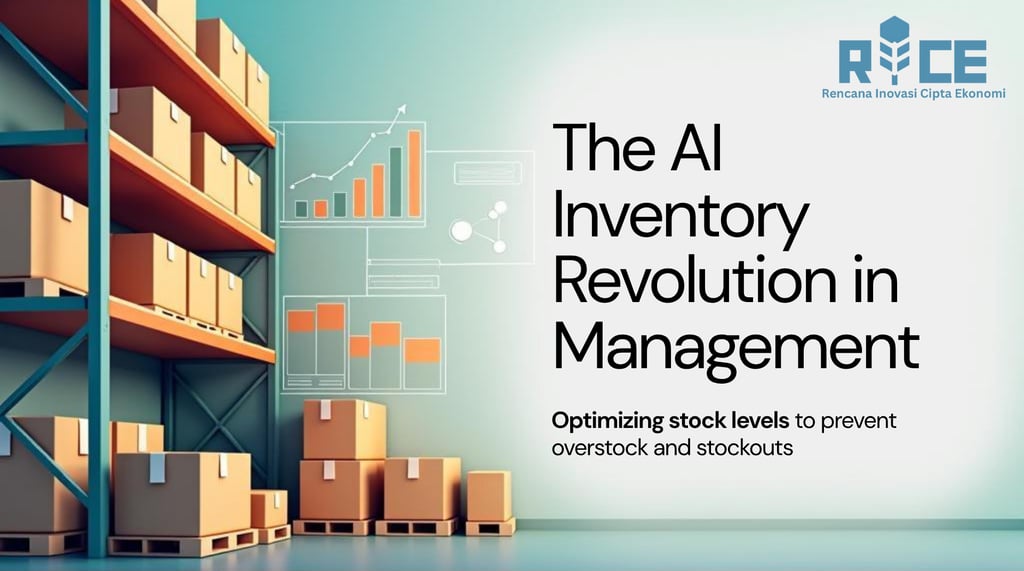The AI Inventory Revolution: Mastering the Delicate Balance Between Overstock and Stockouts
Transform inventory management with AI: Eliminate stockouts, slash overstock costs, and boost resilience using predictive algorithms. Real-world case studies reveal 30%+ efficiency gains.
INDUSTRIES
Rice AI (Ratna)
7/24/20256 min read


In today's volatile market landscape, inventory management has evolved from a backend operation to a critical strategic function determining organizational resilience and profitability. The global supply chain management market reflects this growing importance across industries. Yet despite massive investments, businesses continue to hemorrhage revenue from twin inventory demons: overstock(tying up capital in unsold goods) and stockouts (losing sales and customer loyalty). Traditional inventory methods, relying on historical averages and manual forecasts, crumble under the complexity of modern supply chains. Enter artificial intelligence—transforming inventory allocation from reactive guesswork to predictive science.
The High Cost of Imbalance
Inventory misalignment carries staggering costs that ripple across organizations. Overstock scenarios lock capital in stagnant inventory, incurring significant holding costs annually through warehousing, insurance, obsolescence, and markdown expenses. Conversely, stockouts create immediate revenue leakage—retailers lose substantial sales annually due to out-of-stock scenarios, with critical categories like electronics and perishables suffering even higher impacts. The damage extends beyond immediate sales: many customers encountering stockouts switch retailers permanently, eroding lifetime customer value.
These challenges intensify with market volatility. Geopolitical conflicts, climate disruptions, and shifting trade policies create unprecedented supply chain fragility. Recent analyses highlight vulnerabilities in sectors like electronics and raw materials. Traditional systems lack the analytical horsepower to navigate this complexity, making AI-powered solutions not merely advantageous but essential for survival.
How AI Transforms Inventory Allocation
Artificial intelligence fundamentally reimagines inventory management through three revolutionary capabilities:
Predictive Demand Sensing: Modern AI systems ingest and analyze diverse data streams far beyond historical sales—including weather patterns, social media sentiment, competitor pricing, local events, and macroeconomic indicators. Unlike static models, machine learning algorithms continuously refine predictions based on real-world outcomes.
Dynamic Optimization: AI transcends prediction into prescriptive optimization. By simulating thousands of scenarios, systems determine ideal stock levels across locations, adjusting for constraints like warehouse capacity, transportation lead times, and service-level requirements. Crucially, these systems dynamically recalibrate safety stocks—automatically increasing buffer inventory during supplier instability or disruptions.
Automated Replenishment & Allocation: Intelligent systems convert insights into action through automated workflows. AI triggers purchase orders, transfers between warehouses, and production adjustments based on real-time demand signals and constraint analysis. This continuous optimization replaces static reorder points with fluid, context-aware decision-making.
Comparative Capabilities in Practice
Traditional demand forecasting relied on historical sales averages and manual adjustments, resulting in significant forecasting errors. AI-powered approaches analyze thousands of variables and integrate external factors, reducing errors by 20-50%. Where traditional systems used fixed reorder points, AI dynamically adjusts safety stocks and automates transfer decisions, achieving 15-35% inventory reductions.
In allocation optimization, rule-based monthly distribution reviews have been replaced by continuous simulation and real-time network rebalancing. This shift delivers 65% service level improvements. Most critically, traditional disruption response involved reactive manual intervention taking days, while AI provides predictive alerts and automated mitigation within hours—accelerating response times by 35-40%.
The Technical Engine: How AI Allocation Systems Work
Beneath the business benefits lies sophisticated technical architecture combining multiple AI disciplines:
Machine Learning Foundations: Core forecasting leverages advanced time-series algorithms for baseline predictions, enhanced by ensemble methods to model complex interactions between promotions, pricing, and seasonality. For ultra-complex scenarios, deep learning models capture intricate temporal patterns.
Optimization Mathematics: Inventory allocation translates into a multi-objective optimization problem minimizing costs while maximizing service levels and resilience. Reinforcement learning approaches enable systems to "learn" optimal strategies through simulated outcomes, particularly valuable for navigating unprecedented disruptions. These models incorporate real-world constraints often overlooked in simplified planning.
Real-Time Data Integration: AI systems consume live feeds from IoT sensors, warehouse management systems, electronic data interchange, and point-of-sale data. This creates a closed-loop system where predictions continuously refine based on operational reality.
Bullwhip Effect Mitigation: A critical technical achievement is AI's ability to dampen the bullwhip effect—where small demand fluctuations amplify into massive swings upstream. AI enables real-time visibility and coordination across supply chain partners, synchronizing production and distribution decisions.
Implementing AI Inventory Allocation: Strategic Steps
Transitioning to AI-driven allocation requires methodical execution beyond technology installation:
Data Foundation Development: AI's effectiveness hinges on data quality and accessibility. Organizations must audit existing data, cleanse inaccuracies, and establish pipelines integrating previously siloed sources. For retailers, this often means unifying online/offline sales data previously managed separately.
Process Re-engineering: AI reveals inefficiencies in existing workflows. Successful implementations redesign processes around AI's predictive insights rather than forcing automation into legacy systems. This evolution transforms planners from data crunchers to exception managers interpreting AI recommendations.
Technology Selection & Integration: Solutions range from cloud-based SaaS platforms for rapid deployment to custom AI development for complex operations. Key evaluation criteria include integration capabilities with existing systems, algorithm transparency, scalability, and vendor industry-specific expertise.
Organizational Change Management: Upskilling teams is paramount. Planners need training to interpret AI recommendations and override judiciously when context suggests anomalies. Companies fostering "augmented intelligence" mindsets—where humans and AI collaborate—outperform those pursuing full automation.
Evidence in Action: Industry Case Studies
Real-world implementations demonstrate AI's transformative impact across sectors:
ChemScene (Biopharma): Facing critical inventory challenges with specialized chemicals, ChemScene implemented an AI system integrating advanced neural networks and optimization algorithms. Results after 18 months were transformative: significant sales increases, dramatic stockout reduction, and improved customer retention. Critically, financial metrics showed substantial improvement—demonstrating that AI optimization directly fuels profitability.
Amazon (E-Commerce & Logistics): Amazon's AI allocation engine processes massive data volumes daily, enabling hyperlocal inventory positioning. During peak seasons, it predicts demand for hundreds of millions of items, ensuring high-velocity products are stocked optimally. Results include major increases in fulfillment speed, logistics savings, and sustainability gains through optimized transportation and packaging.
Nestlé (CPG Manufacturing): Transitioning from Excel-based forecasting to AI-powered demand sensing revolutionized planning. By incorporating real-time signals measuring advertising impact and market trends, Nestlé dramatically reduced forecast errors. The AI implementation reversed the ratio of manual adjustments, enabling planners to focus on strategic scenario analysis.
Navigating Limitations and Ethical Considerations
Despite transformative potential, AI inventory systems present implementation challenges requiring thoughtful navigation:
Data Dependency & Quality: AI models falter with sparse historical data or during unprecedented disruptions lacking prior patterns. Solutions include transfer learning techniques and hybrid modeling blending quantitative forecasts with qualitative human insights.
Algorithmic Transparency & Bias: "Black box" algorithms can breed distrust, especially when recommendations contradict planner intuition. Explainable AI techniques help illuminate feature importance in predictions. Furthermore, models trained on historical data may perpetuate past biases—requiring regular bias auditing and incorporating equity metrics.
Over-Automation Risks: Full autonomy remains risky during "edge case" disruptions. Leading practitioners implement human-in-the-loop systems where AI flags uncertain recommendations for human review.
Implementation Costs & Skills Gaps: While cloud solutions lower barriers, customization and integration remain resource-intensive. Many organizations face talent shortages, particularly in supply chain analytics. Partnering with specialized vendors and investing in upskilling prove essential.
The Future of AI in Inventory Allocation
As technology evolves, several frontiers promise further transformation:
Generative AI Integration: Beyond predictive analytics, generative AI simulates complex supply chain scenarios. Planners use natural language prompts to generate risk assessments and mitigation strategies within seconds, revolutionizing strategic planning.
Self-Healing Supply Networks: Next-generation systems move beyond prediction to autonomous correction. Combining digital twins with AI enables systems to proactively reroute shipments or adjust production before humans detect disruptions.
Hyper-Personalized Allocation: For omnichannel retailers, AI will enable store/SKU-level personalization previously unimaginable. Systems will factor in granular local preferences detected through diverse data streams.
Sustainable Stock Optimization: Regulatory pressure and consumer demand are elevating sustainability in allocation logic. AI increasingly optimizes for carbon footprint reduction alongside cost and service levels, creating greener supply chains.
Conclusion: Striking the Balance in the AI Era
Inventory management has transcended its traditional role as a cost center to become a strategic lever for competitive advantage. In an era defined by volatility, AI-powered allocation provides the analytical horsepower necessary to navigate complexity. The evidence is compelling: early adopters achieve significant inventory reductions, forecast error decreases, and service level improvements while unlocking sustainability gains.
However, technology alone isn't a panacea. The most successful organizations recognize that human-machine collaboration delivers superior outcomes to full automation. Real-world transformations illustrate this balance—leveraging AI for data-crunching while empowering planners with advanced tools.
As we advance, the pioneers won't be those who simply install AI tools, but those who cultivate data-driven cultures where supply chain professionals and algorithms jointly navigate the delicate equilibrium between scarcity and surplus. In this balance lies not just operational efficiency, but resilience, customer loyalty, and sustainable growth in an increasingly unpredictable world.
References
Top 13 Supply Chain AI Use Cases with Examples in 2025. AIMultiple. https://research.aimultiple.com/supply-chain-ai/
A Machine Learning Approach to Inventory Stockout Prediction. ScienceDirect. https://www.sciencedirect.com/science/article/pii/S2773067025000202
How AI is Changing Logistics & Supply Chain 2025. DocShipper. https://docshipper.com/logistics/ai-changing-logistics-supply-chain-2025/
AI Inventory Management Prevents Stockouts & Overstock. Seven Square Tech. https://www.sevensquaretech.com/ai-inventory-management-ecommerce-stockouts-overstock/
AI Will Protect Global Supply Chains from the Next Major Shock. World Economic Forum. https://www.weforum.org/stories/2025/01/ai-supply-chains/
AI-Powered Inventory Systems: Reducing Stockouts and Overstocks. The Visual Communication Guy. https://thevisualcommunicationguy.com/2025/04/04/ai-powered-inventory-systems-reducing-stockouts-and-overstocks/
AI in Supply Chain: A Strategic Guide [2025-2030]. StartUs Insights. https://www.startus-insights.com/innovators-guide/ai-in-supply-chain/
AI-Based Inventory Management for Retail Supply Chain Optimization. JKLS Journal. https://jklst.org/index.php/home/article/view/262
Supply Chain Trends 2025: The Impact of AI. EASE Logistics. https://easelogistics.com/2025/05/14/supply-chain-trends-for-2025-the-impact-of-artificial-intelligence/
AI Predictions On 2025 Supply Shortages and Industry Impact. Forbes. https://www.forbes.com/sites/garydrenik/2025/03/11/ai-predictions-on-2025-supply-shortages-and-industry-impact/
#AIinventory #SupplyChainTech #PredictiveAnalytics #InventoryOptimization #RetailTech #AIsupplychain #DemandForecasting #LogisticsInnovation #DigitalTransformation #AIinRetail #DailyAIIndustry
RICE AI Consultant
To be the most trusted partner in digital transformation and AI innovation, helping organizations grow sustainably and create a better future.
Connect with us
Email: consultant@riceai.net
+62 822-2154-2090 (Marketing)
© 2025. All rights reserved.


+62 851-1748-1134 (Office)
IG: @riceai.consultant
